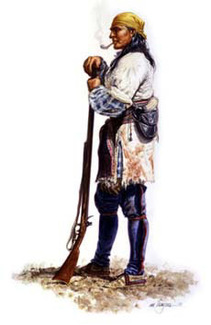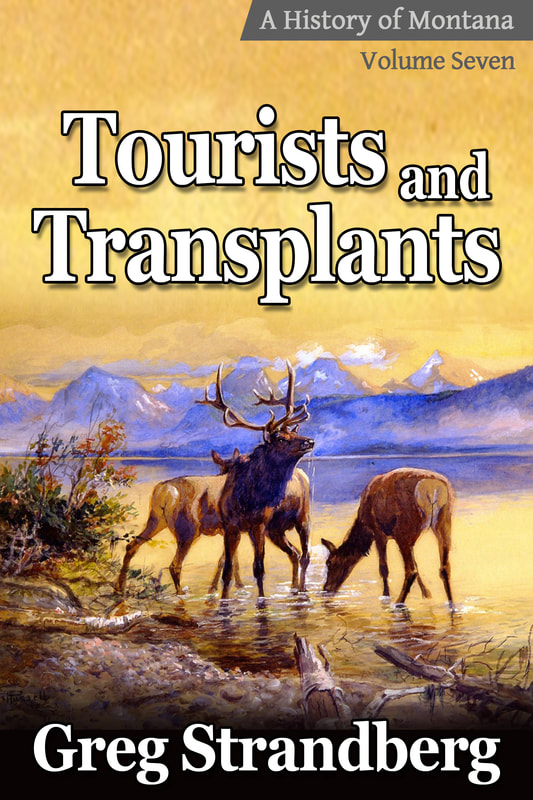 George Drouillard
George Drouillard
I’m calling it “Colter’s Friend” and that’s mainly because it focuses on George Drouillard.
George Drouillard was a half-Shawnee Indian half-French-Canadian scout that’d accompanied Lewis and Clark to the Pacific and back.
When the Lewis and Clark Expedition made it back to St. Louis in September 1806, Drouillard turned around and got into the fur trade.
He was one of the many trappers that accompanied Manuel Lisa upriver to the Upper Missouri in 1807 to build Fort Raymond and man it over the winter.
The last we saw of him was in Colter’s Run as he headed back to St. Louis in the summer of 1808.
So what is this book about, the one that I’m planning to release in early-December?
Well...I’m not too sure.
I’d like to talk about this book today, both so I can inform you about it...and so I can inform myself.
Yep, I’m not sure of all the pieces and parts yet, but I’m working on it.
Here’s where I’m at.
The St. Louis Story
When I started writing this post in Mid-October I had 5,600 words so far of this book, and it was pretty much a large outline spread over 26 pages.
Today I have 18,000 words spread over 79 pages, most of it chapters starts and actual text.
I have to admit, I don’t change much from the first draft in the way of story.
This book’s story consists of all the characters I have, which are divided like so:
- Whites in St. Louis
- Whites at Fort Raymond
- Blackfeet Indians
- Other Indians
For the “other Indians” I might have to add in the Osage.
The Osage were a tribe that lived along the Osage River, something that branched off from the Missouri about 200 miles west of St. Louis.
Meriwether Lewis went out there in 1808 and built Fort Clark, though it’d later be called Fort Osage.
That change didn’t occur until about 1813 or so, when the War of 1812 was heating up in the region.
That’s a bit farther apace from our novel.
For “Colter’s Friend” we’re going to bring the Captains back in.
That’s Captain William Clark and Captain Meriwether Lewis. The former is now the main Indian Agent for Louisiana Territory and also the head of its militia. He still reports to the Governor of the Louisiana Territory, however, though that man’s in New Orleans.
We’ll also take a look at the Chouteau Family of St. Louis and how they’re the real pull, the money, and the old established order.
Their family started the town and saw it grow into a city. We’ll discuss that, as well as how they can manipulate things to get their way.
Lots of government intrigue here, most with the aim of screwing the Indians out of their land.
The Lewis Sub-Story
For Lewis’s part, he’s now Territorial Governor of Upper Louisiana. That’s a pretty easy job as there’s nothing in that area, except Fort Raymond and maybe some lodging around the Mandan Villages.
Land was important, and Clark got a lot of it. Lewis not so much. That wasn’t too good for him, or his finances. The latter would really plague his conscious, and eventually lead to his suicide.
We’ll go into the head of Lewis in this book and see that suicide up close, the news of it in St. Louis, and the effect on the men.
So the Lewis sub-story is important...though mainly for closing up the Lewis and Clark portion of the history of the Upper Missouri. Clark will be around for some time, into the 1830s in fact.
Drouillard’s Story
Drouillard headed downriver to St. Louis in 1808 and arrived in August. He was immediately put on trial for the murder of Antoine Bissonnett, an event we saw in Colter’s Hell.
We’ll watch the trial and the outcome and what happened to Drouillard next.
Mainly, he gets away and gets upriver and has a terrible time of it. When I say terrible, I mean bad.
Colter’s Story
So where does Colter fit into all of this? Not too many places, to be completely honest.
We’ll look at the fort but we won’t get to Colter until the second half of the book. After that he’ll guide the men to the area he had his run. Once there it’s decided they’ll build a new fort.
This is Fort Henry, named for Andrew Henry.
Oh yeah, we’ll talk about this famous trapper, explorer, miner, and businessman that straddled both the early fur trade (1806-1812) and the latter (1822-1840).
He’s our link to William Henry Ashley and the later stories we can get to if these books keep on selling.
So Colter guides them and they build the fort. That’s where the Indians come in.
The Indians’ Story
One of my favorite parts of writing these books are the Indians. I like the Blackfeet, and they’re both villains and heroes at times.
It really depends on the various bands of the Blackfeet - there are 3 to 4, depending on how you want to look at it...maybe more.
This tribe fought the whites a lot, though the whites fought them first...as we saw in Colter’s Hell.
So what happens?
If you’ve been following the Stone Bear storyline you’ll have a good idea. Chief Big Dog from Colter’s Run is a big part, and we’ll really get into tribal politics.
Yep, lots of intrigue and backstabbing...sometimes literally.
These novels make history fun and entertaining. If you’re interested in early Montana but don’t want to read dry history books, these novels are for you.
I put out Colter’s Winter in April and it’s been in the Top 20 on the bestselling Western-Horror charts ever since.
Colter’s Hell came out last month and has been on that same chart, a few titles behind the first book, all during that time.
Colter’s Run will be out on Tuesday, October 27…though if you’re on my email list you’ll know sooner.
So that’s how it stands. Check out these books on Amazon.
Isn’t it time you took a thrilling ride through Montana’s earliest days?

